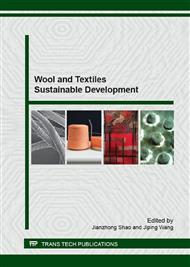p.300
p.306
p.317
p.324
p.331
p.338
p.347
p.356
p.363
Study of Hydrophilic Modification for Polyamide 6,6 and its Characterization
Abstract:
Polyamide 6,6 (PA 6,6) fiber is amongst the most substantial chemical fibers useful in a wide range of apparel and industrial applications. Overlooking the benefits, the poor hydrophilic nature of this fiber cause wet processing crucial and unsatisfactory ease of wearing for clothing. In this work, the surface modification of PA 6,6 fiber were studied by using Subtilisin and Alkali (NaOH). The effects of modification were investigated, including amino group determination by wool reactive dyeing, the surface morphology and chemical analysis by Scanning Electron Microscopy-Energy Dispersive Spectrometer (SEM-EDS) and Attenuated Infra-Red (ATR-IR). The dye-bath exhaustion and color strength results confirmed the increased amount of amino groups formed after modifications. The increased oxygen content in SEM-EDS results indicates the possible formation of carboxyl group after modifications. Generally, both Subtilisin and alkali treatments resulted in improvement of hydrophilicity and other properties of PA 6,6 fabrics; although Subtilisin treatment considered as clean and eco-friendly treatment in regards of environmental matters.
Info:
Periodical:
Pages:
331-337
Citation:
Online since:
November 2015
Authors:
Price:
Сopyright:
© 2016 Trans Tech Publications Ltd. All Rights Reserved
Share:
Citation:


